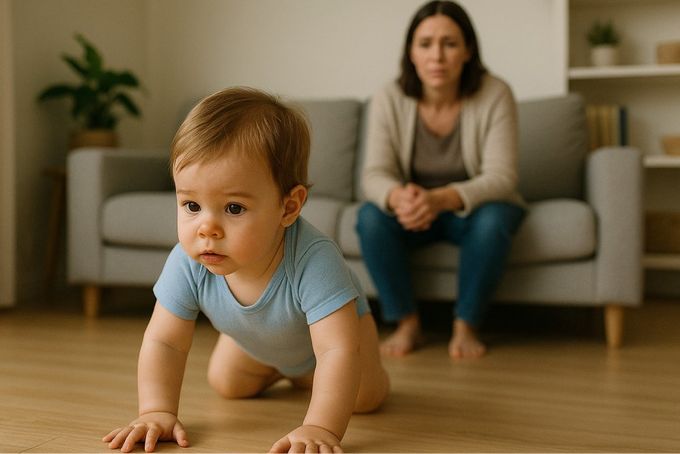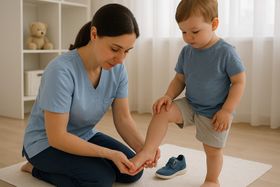What Causes a Child to Walk Late? Expert Insights for Parents
Most children who walk late catch up by age two, with causes ranging from treatable physical conditions to simple environmental factors like limited floor play time. The key is distinguishing between normal developmental variation and delays that require medical attention.
Published July 13, 2025

As a pediatrician, I often meet moms worried because their toddler isn’t walking yet. You’re counting the months, wondering if something’s wrong.
It’s tough seeing other kids toddle while yours still crawls. The fear that this could signal a bigger issue keeps you up at night.
With 20 years of experience, I’ve helped countless families through this. I’ll explain why some kids walk late and share clear steps you can take to support your child’s first steps.
How Does Normal Walking Development Look?
Children typically begin walking independently between 8 and 18 months old [1]. Most take their first steps by 12 months. The World Health Organization considers this entire range normal, giving you room to breathe when your little one falls outside the average [2].
Before walking, several motor milestones must take place:
- Infants develop enough trunk muscle strength to sit without support.
- They start crawling, scooting, or moving in various ways to navigate their environment and build their strength [3]. Some babies might skip this step.
- Next, they often pull themselves to a standing position using furniture, then progress to cruising (walking while holding onto objects) for balance and coordination.
The Centers for Disease Control and Prevention (CDC) offers milestone tracking tools through their “Learn the Signs. Act Early.” program. It helps parents monitor developmental progress from ages 2 months to 5 years and know when to seek help
If your toddler is stuck in the cruising stage, don't worry. Some kids can walk independently, but prefer holding a parent's finger. They still lack the confidence to let go. That's not the same as true delayed walking.
Gender also doesn't affect walking onset. Research shows no association between when boys and girls start walking [4]. Differences only appear later in sports-related skills like throwing and hand-eye coordination.
When Should You Be Concerned About a Walking Delay?
Most children begin walking sometime between 12 and 18 months, but there's a wide range of normal. Some toddlers take their time, especially if they’re focused on mastering other motor skills.
Still, if walking hasn’t started by around 18 months, it’s worth checking in with your pediatrician, just to rule out anything that might be slowing things down. As kids grow older, like into their second or even third year, delays become more noticeable and often benefit from a more thorough evaluation.
Other concerning signs include:
- Muscle weakness
- Abnormal muscle tone
- Difficulty maintaining balance while sitting
- Significant delays in other motor milestones
- Family history of genetic or neurological conditions
- Regression in previously achieved motor skills.
How Age Affects the Level of Concern
Pediatricians often use standardized screening tools to assess walking and other developmental delays. Tools like the Ages and Stages Questionnaire (ASQ) or the Child Development Review – Parent Questionnaire help identify whether your child is meeting appropriate milestones.
These checklists look at multiple areas of development, such as motor skills, language, problem-solving, and social interaction. Your pediatrician uses them as a guide in deciding next steps.
And if a 3-year-old is still not walking, that typically points to a significant delay that requires an evaluation from multiple medical professionals.
As part of the evaluation, doctors often assess head circumference, body mass index (BMI), and other growth parameters to look for signs of underlying conditions that could affect motor development.
In certain cases, your pediatrician may also recommend neuroimaging, such as an MRI or CT scan, especially if there are signs of neurological abnormalities like persistent muscle tone issues or asymmetric movement.
Physical Causes of Delayed Walking
Congenital Hip Dysplasia
Congenital hip dysplasia affects how the hip socket forms [5]. During routine well visits in the first year, pediatricians examine hip movement.
When they detect problems, they might perform a hip evaluation and x-rays to confirm the diagnosis. Treatment for this condition usually involves wearing a harness device through age 6 months to reshape the hip sockets.
This allows the top of the femur to fit properly. If detected later or if harnessing fails, a medical specialist might suggest casting or surgery [5].
Congenital Foot Deformities
Congenital foot deformities also impair walking ability [6]. Congenital club foot occurs in two out of 1000 newborns [7]. While it may be associated with genetic disorders, 80% of cases are isolated findings [8]. Treatment involves casting to stretch muscles and reshape the foot, or daily physical therapy.
On the other hand, a condition called metatarsus adductus can create a "c-shaped" appearance in one or both feet. It also affects two out of 1000 infants [7]. Some children outgrow it without intervention, while others benefit from physical therapy, serial casting, or orthotics.
Neurological and Genetic Causes of Delayed Walking
Hypertonia
Hypertonia causes stiffness or tightness in leg and foot muscles [9]. These infants have legs that resist flexing at the ankles or bending at the knees. When held upright, kids keep their legs extended and may point their toes.
This muscle tightness, specifically in the Achilles tendons, can lead to complications. It may result in unbalanced toe-walking. Some infants also experience spasticity, where the leg remains in a very tight, flexed position.
Hypotonia
In contrast to hypertonia, some infants experience hypotonia. This condition reduces the core muscle tone, making sitting or standing upright difficult. When held upright, these babies may slide downward and out of their parents' hands due to weak trunk support.
In certain conditions, truncal hypotonia can occur alongside arm and leg hypertonia, leading to a complex mix of muscle tone abnormalities [10].
Hemiparesis
Hemiparesis causes stiffness or weakness on one side of the body [11]. Brain injury from meningitis or birth hypoxia can impair movement in one leg. The muscles may be tight, making it difficult to straighten or extend the leg.
On the other hand, the baby's muscles may be weak, which may manifest as decreased use or dragging of the affected leg.
If there's a family history of developmental conditions, your pediatrician might recommend genetic testing to rule out inherited syndromes. These tests can help uncover the underlying causes of unexplained delays.
Birth Complications That May Cause Delayed Walking
Premature Birth
- Premature infants born before 37 weeks of gestation face particular challenges.
- Those born before 33 weeks achieve walking and other motor milestones later than full-term infants [12, 13].
- Even infants born between 33 and 36 weeks may show mild delays, especially with post-birth complications.
Proper assessment of preterm infants requires using "corrected age," which is the baby's current age minus the weeks premature [14]. A 2-month-old baby born at 32 weeks (8 weeks early) should have newborn-level developmental skills. So, you should expect a two-month delay in walking onset.
Most premature infants receive follow-up care from neonatal teams after hospital discharge. When a medical professional notices a delay, they usually suggest physical therapy as the first intervention.
This can increase muscle strength or improve leg flexibility. With appropriate interventions, most infants catch up to their peers by age two to three [15].
For children diagnosed with medical conditions that impair walking, no specific "catch-up age" exists. How quickly they start walking depends on the underlying condition and response to treatment.
Intrauterine Growth Retardation
Intrauterine growth retardation restricts fetal growth due to reduced placental blood flow, maternal chronic illnesses like diabetes or lupus, or fetal organ malformations.
These newborns weigh below the 10th percentile [16]. Because brain formation and innervation are impaired, these babies experience developmental challenges including delayed walking [17].
Prenatal Exposure to Toxins
Prenatal exposure to toxins like nicotine, recreational drugs, and alcohol adversely affects the developing brain. Cocaine exposure is particularly associated with delayed motor skills [18]. These babies have increased muscle tone in their legs, making sitting alone and crawling difficult.
They often toe-walk and have balance difficulties. Most respond well to physical and occupational therapies when intervention begins early.
In rarer cases, delays in walking may be linked to metabolic disorders, vitamin B12 or folate deficiencies, or biotinidase deficiency, a condition that affects how the body processes certain nutrients.
These conditions can interfere with energy production in muscles and nerves. Pediatricians may run lab tests to detect these less common but treatable issues.
Environmental Causes of Delayed Walking
The most common non-medical cause of delayed walking is limited opportunities to practice. Infants and toddlers who are frequently held or carried have minimal floor playtime.
- "Tummy time" increases head and neck control while building core and arm strength. Aim for one to two minutes of tummy time or floor play after every diaper change.
- For older infants, floor play encourages rolling, crawling, and cruising. The American Academy of Pediatrics also recommends 30 to 60 minutes of daily floor play for infants [19].
Infant walkers have regained popularity despite previously being removed from the market. While babies may seem agile in walkers, they become accustomed to the upper body support in the process.
Most studies find that they delay independent walking ability. After discontinuing walker use, children typically begin walking independently within one to two months.
The Path Forward for Late Walkers
Most kids who take a little longer to walk eventually catch up, especially when no underlying medical issues are present. If your toddler seems hesitant to take those first steps or is moving more slowly than peers, it’s okay to ask questions.
Sometimes a bit of extra support, like physical therapy or more floor time, is all that’s needed. But if walking still hasn’t started well into the second year or beyond, your pediatrician can help you explore next steps and make sure everything is on track.
Proper footwear also plays a crucial role in supporting walking development. Quality orthopedic shoes designed for first walkers provide necessary support and protection while allowing natural movement patterns to develop.
First Walkers offers specialized orthopedic shoes designed to support healthy foot development in children taking their first steps. These shoes include features that promote proper gait development while protecting delicate, growing feet.
References:
- C. M. Hospodar, J. E. Hoch, D. K. Lee, P. E. Shrout, and K. E. Adolph, “Practice and proficiency: Factors that facilitate infant walking skill,” Developmental Psychobiology, vol. 63, no. 7, Sep. 2021, doi: 10.1002/dev.22187. Available: https://pmc.ncbi.nlm.nih.gov/articles/PMC8550266/
- WHO Multicentre Growth Reference Study Group, “WHO Motor Development Study: Windows of achievement for six gross motor development milestones,” Acta Paediatrica Supplement, vol. 450–450, pp. 86–95, 2006, Available: https://cdn.who.int/media/docs/default-source/child-growth/child-growth-standards/indicators/motor-development-milestones/mm_windows_graph.pdf?sfvrsn=ea3a0241_5
- J. Hua et al., “Early Motor milestones in infancy and Later Motor impairments: A Population-Based Data Linkage Study,” Frontiers in Psychiatry, vol. 13, Jan. 2022, doi: 10.3389/fpsyt.2022.809181. Available: https://doi.org/10.3389/fpsyt.2022.809181
- “Cross-sectional survey of gender differences in gross motor skills among preschool children in Jinhua City, China,” Heliyon, Available: https://www.sciencedirect.com/science/article/pii/S2405844024159038
- T. Nandhagopal, V. Tiwari, and F. L. De Cicco, “Developmental dysplasia of the hip,” StatPearls - NCBI Bookshelf, May 04, 2024. Available: https://www.ncbi.nlm.nih.gov/books/NBK563157/#article-22896.s8
- “The global birth prevalence of clubfoot: a systematic review and meta-analysis,” eClinical Medicine, Available: https://www.thelancet.com/journals/eclinm/article/PIIS2589-5370(23)00355-3/fulltext
- “Metatarsus adductus: Development of a non-surgical treatment pathway,” Journal of Paediatrics and Child Health, Available: https://www.researchgate.net/publication/236641656_Metatarsus_adductus_Development_of_a_non-surgical_treatment_pathway
- V. Mousafeiris, M. A. Dreyer, and A. Thomas, “Pediatric foot alignment deformities,” StatPearls - NCBI Bookshelf, Aug. 10, 2023. Available: https://www.ncbi.nlm.nih.gov/books/NBK592393/
- T. D. Sanger, M. R. Delgado, D. Gaebler-Spira, M. Hallett, and J. W. Mink, “Classification and definition of disorders causing hypertonia in childhood,” PEDIATRICS, vol. 111, no. 1, pp. e89–e97, Jan. 2003, doi: 10.1542/peds.111.1.e89. Available: https://publications.aap.org/pediatrics/article-abstract/111/1/e89/28548/Classification-and-Definition-of-Disorders-Causing?redirectedFrom=fulltext?autologincheck=redirected
- “Development of muscle tone impairments in high-risk infants: Associations with cerebral palsy and cystic periventricular leukomalacia,” European Journal of Paediatric Neurology, Available: https://www.sciencedirect.com/science/article/pii/S109037982100235X
- A. Varma et al., “Pediatric patients with hemiplegia: A systematic review of a randomized controlled trial,” Cureus, Jan. 2023, doi: 10.7759/cureus.34074. Available: https://pmc.ncbi.nlm.nih.gov/articles/PMC9946895/
- J. M. Zubler et al., “Evidence-Informed Milestones for developmental surveillance Tools,” PEDIATRICS, Feb. 2022, doi: 10.1542/peds.2021-052138. Available: https://pmc.ncbi.nlm.nih.gov/articles/PMC9680195/#S9
- N. Sangkarit, W. Tapanya, A. Srithawong, P. Amput, and B. Suwannakul, “Predicting Age of independent walking in preterm infants: A Longitudinal study using neonatal characteristics and motor development variables,” Annals of Rehabilitation Medicine, vol. 48, no. 1, pp. 65–74, Feb. 2024, doi: 10.5535/arm.230012. Available: https://doi.org/10.5535/arm.230012
- W. Cheng et al., “Investigation of the catch-up status and termination for corrected age of neurodevelopment in premature infants of different gestational ages,” Translational Pediatrics, vol. 13, no. 11, pp. 1913–1922, Nov. 2024, doi: 10.21037/tp-24-243. Available: https://pmc.ncbi.nlm.nih.gov/articles/PMC11621893/
- W. Cheng et al., “Investigation of the catch-up status and termination for corrected age of neurodevelopment in premature infants of different gestational ages,” Translational Pediatrics, vol. 13, no. 11, pp. 1913–1922, Nov. 2024, doi: 10.21037/tp-24-243. Available: https://pmc.ncbi.nlm.nih.gov/articles/PMC11621893/
- D. Sharma, S. Shastri, and P. Sharma, “Intrauterine growth restriction: antenatal and postnatal aspects,” Clinical Medicine Insights Pediatrics, vol. 10, Jan. 2016, doi: 10.4137/cmped.s40070. Available: https://pmc.ncbi.nlm.nih.gov/articles/PMC4946587/#:~:text=IUGR%20is%20the%20common%20end,socioeconomic%20status%20and%20developing%20country
- J. Hartkopf et al., “Impact of intrauterine growth restriction on cognitive and motor development at 2 years of age,” Frontiers in Physiology, vol. 9, Sep. 2018, doi: 10.3389/fphys.2018.01278. Available: https://pmc.ncbi.nlm.nih.gov/articles/PMC6156264/
- A. W. F. Cheng et al., “The physical and developmental outcomes of children whose mothers are substance abusers: Analysis of associated factors and the impact of early intervention,” Frontiers in Pediatrics, vol. 10, Oct. 2022, doi: 10.3389/fped.2022.1004890. Available: https://doi.org/10.3389/fped.2022.1004890
- K. Snyder, J. P. Rech, K. Masuda, and D. Dinkel, “Perspectives of infant active play: a qualitative comparison of working versus stay-at-home parents,” BMC Public Health, vol. 21, no. 1, Jan. 2021, doi: 10.1186/s12889-021-10286-x. Available: https://pmc.ncbi.nlm.nih.gov/articles/PMC7847006/
Disclaimer: First Walkers' information is intended for educational and informational purposes related to toddler footwear and feet. We encourage you to consider individual circumstances and consult qualified orthopaedists about specific conditions.
FAQs
Is late walking genetic?
Yes, genetics can play a role. If parents or siblings walked late but were otherwise healthy, the child may simply be following a similar pattern.
Can ADHD cause delayed walking?
Not typically. ADHD mainly affects attention and behavior, not gross motor milestones. But co-occurring developmental conditions could contribute to delays.
What is an alternative to a walker?
Push toys, activity tables, and supervised cruising along furniture are safer alternatives that support walking without the risks associated with traditional walkers.
Can a child be delayed and not have autism?
Yes, a child can be developmentally delayed without having autism. Delays in speech, motor skills, or social development can result from a range of factors, such as hearing loss, prematurity, low muscle tone, or limited exposure to stimulation.
Not all delays are linked to autism, and many children catch up with early support or therapy.




